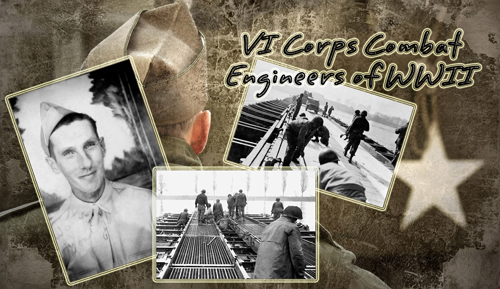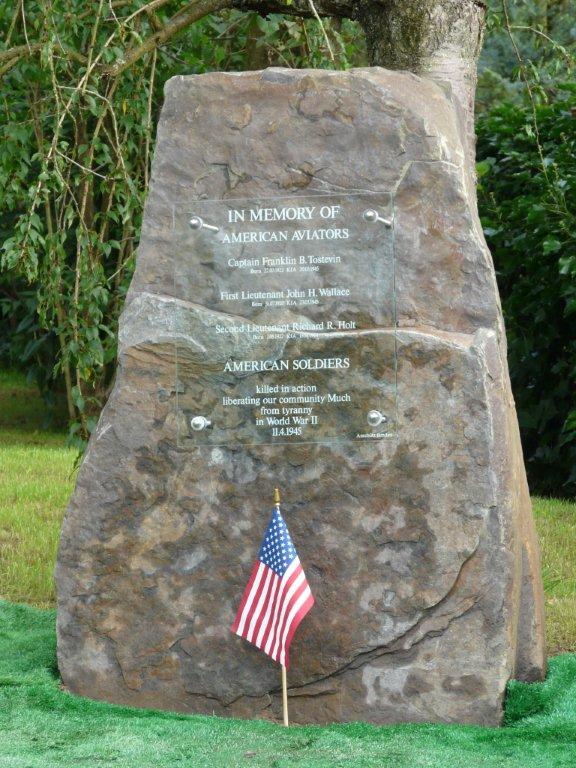From a friend of mine
Viele Grüße aus Much Germany
Thomas Anschütz
How Much was taken in April 1945
This Report was written on the 28th of October 2008 by Ralf Anton Schäfer, a German historian, who had written 4 Books and other reports with military history. The following narrative is based on the After Action Reports of the 97th US Infantry Division and there 386th Infantry Regiment, personnel collected information’s and contains also memoirs from Mucher citizens, which were provided by Thomas Anschütz.
The so called Trident Division – the 97th Infantry Division – reached the Sieg River with last elements on the Morning of the 6th of April and started immediately with extensive patrolling in the area north of the Sieg River. There revealed information: the enemy opposite was mainly from the 3. Fallschirm Jäger Division, from who also was received the most and fanatically resistance in the divisions sector. After the 78th Infantry Division had crossed the Sieg River line on 6th April 1945 in there advance zone to clear out the Ruhr pocket, the 97th Infantry Division received there orders to attack across the River with target of Düsseldorf.
The Attack started with first elements of the 386th Infantry Regiment on the 7th of April at 12.00 AM. After the Divisions artillery opened with a fire barrage of 30 minutes on the German frontline to prepare for the assault boats of the 322nd Engineers, the infantry boarded the boats in small units and was shipped across the river, the initial assault was a full success, losses were only light and contact to the right neighbor, the 78th Inf. Div. was made. A bridgehead had been established.
Now it was the time to bring the other elements in the line: the 1st Battalion of the 387th attacked at 14.00 on the 8th April as planned. Meanwhile the 322nd Engineers had build behind the assault sector of the 386th a footbridge, two support rafts and a tread way bridge, to enabling heavy troop reinforcements to cross rapidly and bolster the attack.
The Bridgehead was growing larger from minute to minute and on the 8th and 9th of April Ruppichteroth and Felderhof were reached, here were enemy strong points heavily defended in the sector of the 1st and 3rd Battalion. Enemy tanks were reported at Heide, a small village in the zone of operations. An airstrike was requested in order to remove this thread to the advancing troops. The danger was removed by several P47s in spite of some opposition from flak guns.
The enemy seemed to defend in small groups at key terrain features and in Towns, where the howitzers of the 365th Field artillery did an excellent job. Road blocks of all features were encountered; felled trees, log barricades of uniform construction, road craters, blown bridges, etc. Some of theses road blocks were mined and protected by sniper fire. The first Objective – the Brölbach – was reached at approximately 14.00 and at 14.40 the Combat teams were ordered to cease there advance, consolidate there positions and clear out the rear area from overrun German positions.
On 8.00 in the Morning of the 10th of April the division ordered to restart the attack. Also the division gave order to change movement of the advance into the north western direction. So the regimental commander ordered his three battalions from right to left starting at 8.00 for the 1st Bn., 10.00 for the 2nd Bn. and 12.00 for the 3rd Bn. After a firefight at Felderhof and Schönenberg, the advance moved from 12.15 rapidly until units of the 386th Regt. reached the line of Bröleck – Marienfeld, where enemy troops where again encountered.1
From Marienfeld the Gi´s spread out to take the villages from left to the right Werch – Nieder- and Oberdreisbach and Oberbohnrath; owned by elements of the German 353. Volksgrenadier Division. Werch was defended by a fanatic Nazi, who lived then in Much. This Nazi had forced a handful of youngest boys at age of around 16 Years, to defend the village. Armed with handguns and only in civilian clothes, they went into position, when the American infantry closed in on Werch, the german group opened fire and one GI was shot into his stomach and was severally wounded. This was the fact, why the American company commander would order artillery and an airstrike on Much, but concerning this, read later more.
In Oberdreisbach a German sniper opened meanwhile fire from a Henhouse and killed 2 American soldiers who where advancing from the south; the sniper was killed in action when the Americans reached Oberdreisbach approximately 2 hours later. After the resistance in the before named villages was broken by mortar fire the Americans had to fight its way through the hilly Forest with the height 325, called the “Hammers Knüppel”, to secure Berghausen, Niederwahn and Altenhof. In the Forest, where the Germans were entrenched and received support of artillery and mortars, a heavy firefight occurred and 6 or 7 American soldiers died in the battle, witch last until the next day. Others where wounded. This strongpoint had to taken in assault after German soldiers were killed.
Meanwhile it has become late and the Americans didn’t count with so hard resistance in the area around the Town Much and the appearance of civilian boys under weapons, lead by a fanatic Nazi. So they ordered the 365th artillery battalion for a fire support mission on the German strongpoint in the Forrest and on the Town Much.
But just before the fire barrage did start on the Town, three Germans, a catholic priest together with the sacristan of the St. Martinus church and one Mucher citizen, came to negotiate with the American company commander in Werch. Armed with only a white Flag they walked from Much to Werch where the Front stood over the night, and stated that there was no one German soldier left in the Town and that the Town itself could be taken without any firefight and difficulty. They learned that the artillery was right in position and would start immediately with a heavy fire barrage on the Town. Also a staff of P47s should be ordered to strafe the Town by Bombs.
The company commander ordered his artillery not to shot on the Town and called the planed airstrike back to ground. Thanks to this company commander the citizens of Much must be very thankfully to the Americans that they did not destroyed the town with artillery or by an airstrike. On the next Morning Much fells to American hand, although there occurred a few fire fights in the city, as well last resistance in the forest must beaten down while advancing onwards. Further there was a flak-unit consisting of a few 20mm, 37mm and one 8,8cm Gun in the northwestern area of Much, whose resistance had to be cleared before the GI´s could move on toward there Objectives.
Also from further interesting are the following facts: in the Area of Much there was in the early spring a launching pad based for V2 from the flak regiment 155. To secure the rocket based bombs, there were many flak-units all over the area in the Ruhr. In April 1945 many of the flak-units remained in the Ruhr pocket and fought against the ground based infantry in direct support of the German Wehrmacht.
1 After Action Reports of the 97th Infantry Division and the 386th Infantry Regiment.
Proud Daughter of Walter (Monday) Poniedzialek
540th Engineer Combat Regiment, 2833rd Bn, H&S Co, 4th Platoon
There's "No Bridge Too Far"





